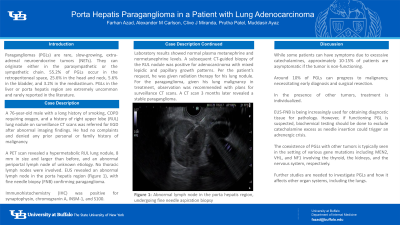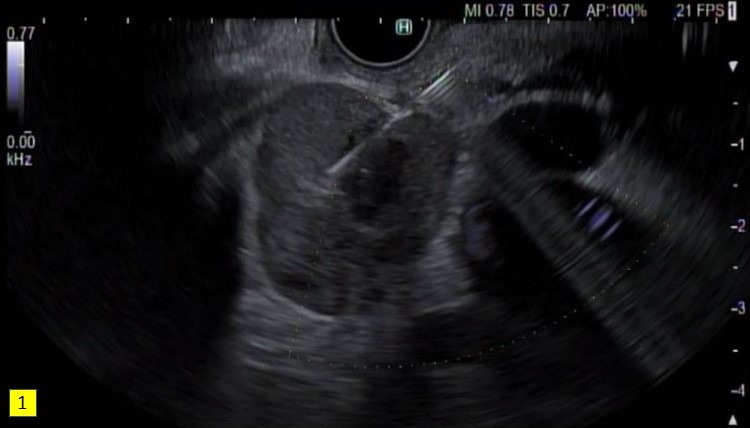Monday Poster Session
Category: Liver
P2582 - Porta Hepatis Paraganglioma in a Patient with Lung Adenocarcinoma
Monday, October 23, 2023
10:30 AM - 4:15 PM PT
Location: Exhibit Hall

Has Audio

Farhan Azad, DO
University at Buffalo
Buffalo, New York
Presenting Author(s)
Farhan Azad, DO, Alexander M. Carlson, DO, Clive J. Miranda, DO, MS, Prutha Patel, DO, Muddasir Ayaz, MD
University at Buffalo, Buffalo, NY
Introduction: Paragangliomas (PGLs) are rare, slow-growing, extra-adrenal neuroendocrine tumors (NETs). They can originate either in the parasympathetic or the sympathetic chain. Research shows that 55.2% of PGLs occur in the retroperitoneal space, 25.6% in the head and neck, 5.6% in the bladder, and 3.2% in the mediastinum. PGLs in the liver or porta hepatis region are extremely uncommon and rarely reported in the literature.
Case Description/Methods: A 76-year-old male with a long history of smoking, COPD requiring oxygen, and a history of right upper lobe (RUL) lung nodule on surveillance CT scans was referred for EGD after abnormal imaging findings. He had no complaints and denied any prior personal or family history of malignancy. PET scan revealed a hypermetabolic RUL lung nodule, 8 mm in size and larger than before, and an abnormal periportal lymph node of unknown etiology. No thoracic lymph nodes were involved. EUS revealed an abnormal lymph node in the porta hepatis region (Figure 1), with fine needle biopsy (FNB) confirming findings consistent with paraganglioma. Immunohistochemistry (IHC) revealed positive markers for synaptophysin, chromogranin A, INSM-1, and S100. Laboratory results showed normal plasma metanephrine and normetanephrine levels. A subsequent CT-guided biopsy of the RUL nodule was positive for adenocarcinoma with mixed lepidic and papillary growth patterns. Per the patient’s preference, he was given radiation therapy for his lung nodule. For the paraganglioma, given his lung malignancy in treatment, observation was recommended with plans for surveillance CT scans. A CT scan 3 months later revealed a stable paraganglioma.
Discussion: While some patients can have symptoms due to excessive catecholamines, approximately 10-15% of patients are asymptomatic if the tumor is non-functioning. Around 10% of PGLs can progress to malignancy, necessitating early diagnosis and surgical resection. In the presence of other tumors, treatment is often individualized. EUS-FNB is being increasingly used for obtaining diagnostic tissue for pathology. However, if functioning PGL is suspected, biochemical testing should be done to exclude catecholamine excess as needle insertion could trigger an adrenergic crisis. The coexistence of PGLs with other tumors is typically seen in the setting of various gene mutations including MEN2, VHL, and NF1 involving the thyroid, the kidneys, and the nervous system respectively. Further studies are needed to investigate PGLs and how it affects other organ systems.

Disclosures:
Farhan Azad, DO, Alexander M. Carlson, DO, Clive J. Miranda, DO, MS, Prutha Patel, DO, Muddasir Ayaz, MD. P2582 - Porta Hepatis Paraganglioma in a Patient with Lung Adenocarcinoma, ACG 2023 Annual Scientific Meeting Abstracts. Vancouver, BC, Canada: American College of Gastroenterology.
University at Buffalo, Buffalo, NY
Introduction: Paragangliomas (PGLs) are rare, slow-growing, extra-adrenal neuroendocrine tumors (NETs). They can originate either in the parasympathetic or the sympathetic chain. Research shows that 55.2% of PGLs occur in the retroperitoneal space, 25.6% in the head and neck, 5.6% in the bladder, and 3.2% in the mediastinum. PGLs in the liver or porta hepatis region are extremely uncommon and rarely reported in the literature.
Case Description/Methods: A 76-year-old male with a long history of smoking, COPD requiring oxygen, and a history of right upper lobe (RUL) lung nodule on surveillance CT scans was referred for EGD after abnormal imaging findings. He had no complaints and denied any prior personal or family history of malignancy. PET scan revealed a hypermetabolic RUL lung nodule, 8 mm in size and larger than before, and an abnormal periportal lymph node of unknown etiology. No thoracic lymph nodes were involved. EUS revealed an abnormal lymph node in the porta hepatis region (Figure 1), with fine needle biopsy (FNB) confirming findings consistent with paraganglioma. Immunohistochemistry (IHC) revealed positive markers for synaptophysin, chromogranin A, INSM-1, and S100. Laboratory results showed normal plasma metanephrine and normetanephrine levels. A subsequent CT-guided biopsy of the RUL nodule was positive for adenocarcinoma with mixed lepidic and papillary growth patterns. Per the patient’s preference, he was given radiation therapy for his lung nodule. For the paraganglioma, given his lung malignancy in treatment, observation was recommended with plans for surveillance CT scans. A CT scan 3 months later revealed a stable paraganglioma.
Discussion: While some patients can have symptoms due to excessive catecholamines, approximately 10-15% of patients are asymptomatic if the tumor is non-functioning. Around 10% of PGLs can progress to malignancy, necessitating early diagnosis and surgical resection. In the presence of other tumors, treatment is often individualized. EUS-FNB is being increasingly used for obtaining diagnostic tissue for pathology. However, if functioning PGL is suspected, biochemical testing should be done to exclude catecholamine excess as needle insertion could trigger an adrenergic crisis. The coexistence of PGLs with other tumors is typically seen in the setting of various gene mutations including MEN2, VHL, and NF1 involving the thyroid, the kidneys, and the nervous system respectively. Further studies are needed to investigate PGLs and how it affects other organ systems.

Figure: Figure 1: Abnormal lymph node in the porta hepatis region, undergoing fine needle aspiration biopsy
Disclosures:
Farhan Azad indicated no relevant financial relationships.
Alexander Carlson indicated no relevant financial relationships.
Clive Miranda indicated no relevant financial relationships.
Prutha Patel indicated no relevant financial relationships.
Muddasir Ayaz indicated no relevant financial relationships.
Farhan Azad, DO, Alexander M. Carlson, DO, Clive J. Miranda, DO, MS, Prutha Patel, DO, Muddasir Ayaz, MD. P2582 - Porta Hepatis Paraganglioma in a Patient with Lung Adenocarcinoma, ACG 2023 Annual Scientific Meeting Abstracts. Vancouver, BC, Canada: American College of Gastroenterology.
